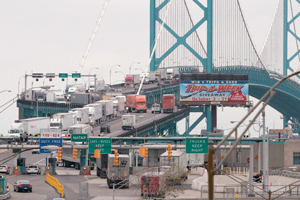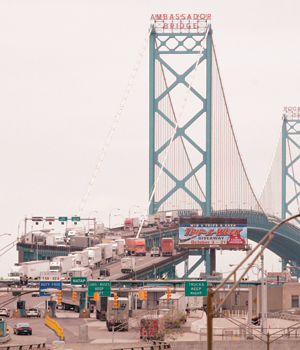Senior Reporter
Canadian Truckers Leery Of Copying US Plan on GHG

 TT File Photo
TT File PhotoThe head of the Canadian Trucking Alliance said he hopes the nation will develop a greenhouse-gas rule that reflects unique operations there and is not simply a clone of the U.S. proposal that is expected to be finalized next year.
CTA President David Bradley said that if Canada does not get the rule right, it could harm the economy of the United States’ largest trading partner.
“We operate in a North American supply chain, so anything that disrupts the productivity or the efficiency, the reliability or the predictability of the supply chain will impact [negatively] upon Canada-U.S. trade,” Bradley, whose group represents fleets, told Transport Topics last week.
Earlier this decade, Canada adopted the exact greenhouse-gas rules for trucks that U.S. regulators passed. However, Bradley is advising against doing the same thing when the Environmental Protection Agency and National Highway Traffic Safety Administration finalize the next phase of the rules, expected in 2016.
The proposal would further tighten greenhouse-gas emissions from heavy- and medium-duty trucks and for the first time regulate trailer efficiency. The proposed rule on carbon dioxide and other GHGs also includes separate standards for engines during that same timeframe.
Fleets will face a series of implementation dates between 2018 and 2027. The comment period on the proposal is scheduled to close Oct. 1.
Bradley said he has urged the Canadian government to fashion a Phase 2 rule that can work in “a Canadian context,” one that accounts for operating conditions, climate and weight limits that differ from the United States.
The Canadian government could “get away” with simply mirroring the Phase 1 regulation, but in Phase 2 the two countries’ fleets are too different, he said.
For example, Canadian provinces each set the vehicle standards — sometimes in different ways for the same component, such as weight limits for wide-base tires. In addition, there are more tractor-trailer configurations hauling higher weights, including multi-axle vehicles weighing 140,000 pounds.
On the basis of the higher payloads, a Canadian fleet is more productive and thus already emits fewer emissions, “and none of that has been recognized in the [proposed] U.S. rules,” Bradley said.
Glen Kedzie, energy and environmental affairs counsel at American Trucking Associations, acknowledged “the Canadians have another layer of complexity built into this because they could be pushed into a box they can’t fit into.”
Kedzie said he spoke with EPA and NHTSA officials earlier this year about the Canadian situation.
“They said they are confident Canada is going to adopt and incorporate by reference the U.S. standard in its entirety,” Kedzie told TT.
He said several of the many expected ways for increasing fuel efficiency and reducing GHG in the next phase of the rule include low-rolling-resistance tires, lighter and more aerodynamic trailers, powertrain improvements and improved aftertreatment technologies and waste heat recovery on engines.
“It’s clear the U.S. rule is going to impose certain technologies,” Bradley said. “We think it is a good thing that the U.S. and Canada move toward harmonization where it makes sense.”
Kedzie also cautioned that whatever happens, EPA has a history of underestimating the cost to fleets, pointing to previous requirements to improve air quality by reducing engine emissions of nitrogen oxides and particulate matter that led to more expensive new engine technologies.
“The biggest concerns with this Phase 2 regulation are how accurate are the costs and what are the market penetration rates. If [EPA and NHTSA] are overestimating those, they are not going to recognize those [anticipated] fuel savings,” Kedzie said.
And if that is the case, Kedzie said, fleets are either going to hold on to existing equipment longer or engage in another pre-buy ahead of the rules’ implementation, as they did in 2005 and 2006. “It’s simple business choices here,” he said.
Summing up the challenges of the fast-approaching rule, Bradley said the Canadian government must “ensure that equipment is properly tested and certified for Canada and not just again take what might work in the United States or not work . . . so that our costs are not completely out of line with U.S. carriers.”

